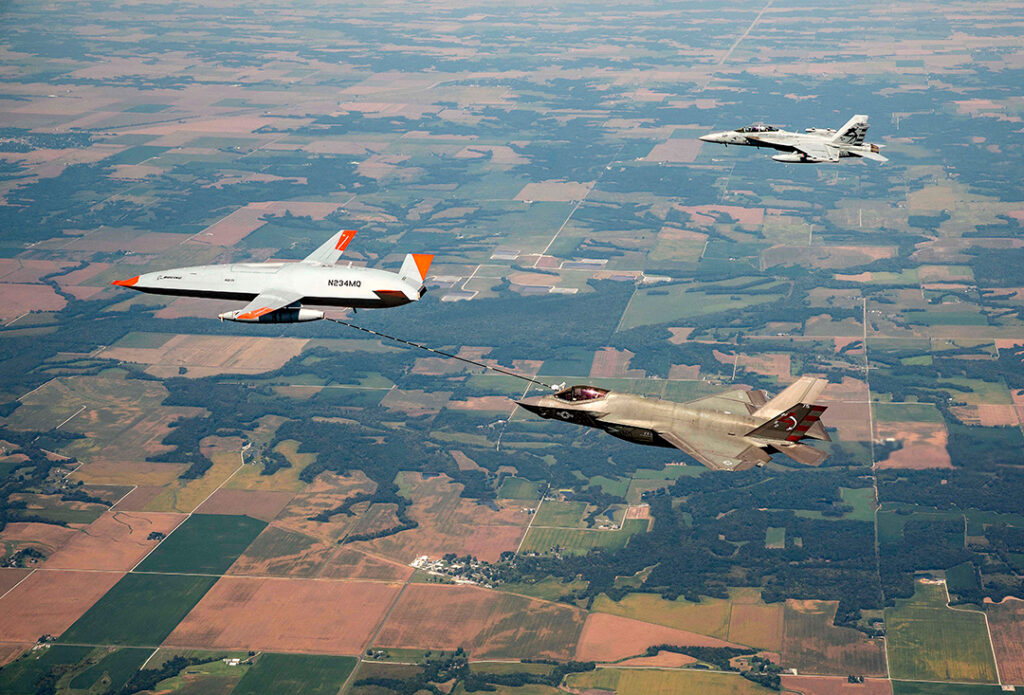THE WATCH STAFF
The U.S. Navy took another flight toward realizing its “air wing of the future” when an unmanned tanker conducted the first aerial refueling with an F-35C Joint Strike Fighter.
The F-35C is the third type of Navy aircraft to top off from the MQ-25 Stingray, which is designed to deploy to carrier strike groups.
The flight with Boeing’s unmanned test aircraft was conducted September 13 near MidAmerica St. Louis Airport in Illinois. During the three-hour flight, an F-35C from the Air Test Wing and Evaluation Squadron Two Three (VX-23) performed formation evaluations, wake surveys, drogue tracking and connected with the MQ-25 at an altitude of 10,000 feet, according to a September 14, 2021, Navy news release. From a ground station, an operator initiated the fuel transfer. (Pictured: The test aircraft connects to the F-35C Lightning II.)
The tests are “our first foray into the carrier air wing of the future, understanding how we integrate it and how we leverage it, how we’re going to use unmanned and manned together in a way that’s going to be quite effective,” said Chief of Naval Operations Adm. Mike Gilday, according to an August 15, 2021, Stars and Stripes newspaper story.
The Navy plans for the MQ-25 to refuel all compatible carrier aircraft. The MQ-25 program has completed unmanned refueling missions with an F/A-18 Super Hornet and E-2D Advanced Hawkeye, according to the Navy news release. Each type of aircraft is aerodynamically unique — so how they respond in the wake of a tanker is different, Capt. Chad Reed, the Navy’s Unmanned Carrier Aviation program manager, said in the news release. By flying different aircraft behind the MQ-25, he said, the Navy can assess how they will interact.
“This flight keeps us on a fast track to getting the Stingray out to the fleet where its refueling capability will greatly increase the range and operational flexibility of the carrier air wing and strike group,” Reed said, according to the news release.
The unmanned aircraft will now be modified to integrate into deck-handling systems in preparation for a shipboard demonstration this year. The MQ-25 will be the first operational carrier-based unmanned aircraft and will provide refueling, surveillance and reconnaissance to support the air wing of the future — a mix of manned and unmanned platforms, and sensors and weapons.
The Navy has announced that it will activate Unmanned Carrier-Launched Multi Role Squadron 10 (VUQ-10) in 2021 at Naval Air Station Point Mugu in California. VUQ-10 will assign refueling detachments to carrier air wings.
The Navy plans eventually to procure 72 of the Boeing-made Stingrays, according to an October 2, 2020, Seapower magazine story. The MQ-25A is scheduled to achieve Initial Operational Capability by 2024. The Navy also has said it plans to use the Stingray for surveillance.
Gilday envisions unmanned systems as a more affordable path to integrated deterrence, according to an April 28, 2021, Seapower story.
“Probably by the mid- to late 2030s, we think up to a third of the fleet could be unmanned, if everything goes right,” Gilday said. “And for the air wing of the future, we think about the same, initially about 40%, potentially going to 60% unmanned” teamed with. fourth- and fifth-generation fighters in contested areas.”
IMAGE CREDIT: U.S. NAVY

